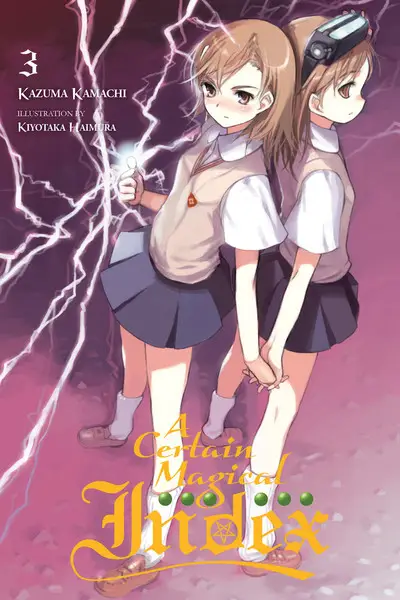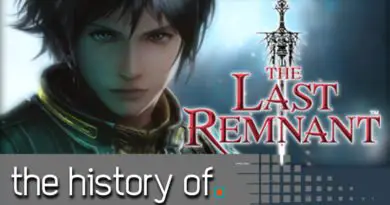A Certain Magical Index Vol. 3 Review + Overview — Sisters Arc — Weakest Vs. Strongest
-
Title: A Certain Magical Index, Vol. 3
Author: Kazuma Kamachi
-
Release Date: May 19, 2015
Publisher: Yen Press

Accelerator, “One-Way Road,” is Academy City’s strongest Esper—the number one-ranked Level Five. A certain girl was trying to snipe him from afar, carefully judging the sway of the wind, almost with robotic precision. She was fully aware of her apparent ineptitude to even do so much as damage this monster who towered over each and every one of Academy City’s Espers to humorous extents. Still, something in her “code” commanded her to do so, despite the chances of victory being one in a million.
We learn a bit more about the habitual activation for Esper abilities, chiefly their two general classifications. They can trigger from manual conscious command or more passively when the body senses peril.
In this case, it’s anyone’s guess which category Accelerator’s abilities operated under when the girl’s bullets did a complete ricochet when colliding with him, striking her instead. Did he sense them from afar, or was it biologically instinctual? Regardless, she faced her end, and that was the end of that.
It was August 20.
Following the events regarding Deep Blood and the wielder of Ars Magna, Aureolus Issard, Touma Kamijou was returning from Summer classes, deciding to get a drink from a certain vending machine that, characteristically fitting his misfortune, did not work even after inputting money. Then, to add to his misfortune, a certain middle schooler appeared. She was a girl that “this” Touma Kamijou did not know, but his dead past self did, Mikoto Misaka—the third-ranked Level 5 of Academy City, the Railgun.
The two’s friendship(?) or acquaintanceship rather was retained, though Touma obviously had to upkeep the facade. The girl revealed that she had a…particular method of getting drinks from that vending machine without inputting money, which is a criminal act but whatever.
“Tokiwadai Middle School style—Old Lady Forty-Five-Degree-Angle Machine-Restarting Strike!”
Mikoto just kicks it. (I distinctly recall her just yelling “Chaser!” when kicking it in the anime, but translations likely differ). After laughing at Touma for wasting two-thousand yen on the vending machine, she decided to help him out by shocking it until it spits out two-thousand yen worth of drinks. He did the natural thing in response and ran away for about ten minutes, not wanting to get involved so his misfortune could fester further.
The Railgun eventually caught up with plenty of drinks in hand. The two converse for a while, one topic being Touma’s apparent propensity for running away. While this Touma wasn’t aware, his past self defeated Mikoto, which seems to keep her up at night. This brings the egotism of the Level 5s and all higher Levels in general to light.
The world’s natural order is that the weak cower and run while the strong stand atop supreme. Mikoto acknowledged this fact yet noted how it did not apply to Touma. He was an exception of exceptions. Someone powerful who, according to Mikoto, claimed and falsified weakness. She was upset that someone she lost to acted the way he did, without a care in the world, because while not explicitly said, it wounded her pride even more than the initial loss did.
Conversely, Touma was more concerned about the insinuation that his past self beat up a middle school girl, so he was having a mild existential crisis there. But when Mikoto unwittingly pointed out in annoyance that he never attacks and always guards, he felt relieved and even impressed by the past Touma Kamijou.
Eventually, Kuroko Shirai appeared, Mikoto’s roommate and a Level 4 Teleporter. It becomes immediately evident that she has quite a strong attachment to Mikoto by calling her Big Sister. And she gets the wrong idea about the accidental meetup with Touma, believing it to be a rendezvous. Regardless, she eventually leaves before another younger-sister figure of Mikoto appears. Except this one looks…identical to her. Her height, face, and everything about her appearance looks exactly like Mikoto Misaka, except for the military-grade goggles adorning her head.
The goggles are worn because this younger Misaka “has no skill at seeing the flow of electricity or magnetism,” necessitating an apparatus for visualization.
That, and her way of speaking, was peculiar, as she referred to and described herself in the third person as if she were reading a book aloud. She has a sense of humor that accuses Touma of being the thief of the certain vending machine nearby, causing him to look at Mikoto for help. She was oddly quiet, though, choosing to unsubtly leave the scene with her “twin sister” in tow, with a veiled forceful approach that Touma could detect was hiding indiscernible emotional intensity.
This scene also introduces the two organizations in Academy City that maintain peace: Judgment and Anti-Skill. The former comprises several Espers from schools, while the latter comprises teachers who keep unruly ones in line with “next-generation weaponry.”
Joining either group takes quite a long while, requiring “nine contractual agreements, [taking] thirteen different aptitude tests, and [overcoming] four months of training before [prospective members are] able to call themselves professionals.”
On Touma’s way back to his dorm with plenty of vending machine drinks in both hands, he encounters the younger, oddly speaking Misaka, the one who speaks in the third person. She chooses to help carry back the numerous drinks he’s carrying, much to his chagrin. It’s worth emphasizing that Touma Kamijou, regardless of his past or post-memory-loss state, is not a person who willingly accepts the help of others.
At the dorm, we’re introduced to Maika Tsuchimikado, the sister of Touma’s next-door neighbor and classmate, Motoharu Tsuchimikado. She is a maid-in-training who attends a school for the profession and constantly sneaks into her brother’s dorm for…reasons. She’s a bit of a quirky character. Then at Touma’s dorm proper, both Index and Himegami are present, with the latter now adorning a Celtic cross necklace crafted by a part of the Walking Church. This seals her Deep Blood capabilities, assuming Touma’s Imagine Breaker doesn’t negate it.
With Himegami’s abilities now sealed, the elite academy she attended would kick her out, effectively leaving her alone. Thankfully, Komoe has taken her in for the time being, and, spoilers, we’ll be seeing her as a transfer student in Touma’s class. A lengthy event occurs, resulting in the younger Misaka using a specific frequency of static electricity to kill fleas living on Sphinx. So, that’s a thing. Index comes up with a nickname for her, too, “cool beauty.”
Following days of remedial classes, Touma yearns to go to the beach, and he runs into the Railgun again. The two do their usual bickering, with Mikoto apparently growing jealous over Touma’s desire to thank her sister for her help with carrying the cans the other day. It’s just in a joking manner, though. Probably.
When seeing a nearby news blimp, Mikoto remarks that she dislikes how “people are following policies decided on by machines.” This brings to the conversation to Tree Diagram, the world’s most intelligent supercomputer used to give weather forecasts so accurate that it’d be more akin to call them weather prophecies. There’s plenty that goes into it, but there are, of course, rumors revolving around the supposedly true purpose of its existence, such as using its immense processing power for medicine and experimentation.
Thankfully, at least for Academy City funders and higher-ups, Tree Diagram itself was a satellite called Orihime, so the chances of it coming to harm by humans seeking to copy the capabilities of its predictive prowess were practically nonexistent. Still, Mikoto vaguely doubted the authenticity of such an “absolute simulator” existing at all, her tone constantly switching between solemness and a sort of faux glee. Touma wasn’t sure what to make of her when they parted ways.
On his way back home, he ran into the younger Misaka again, learning that animals don’t like approaching her because of her powers constantly producing a weak electric field. This also applies to Mikoto. Alas, for the younger Misaka, there was a cat she wanted to feed but couldn’t because of this supernatural dilemma. Touma eventually convinces her to adopt it, though she has difficulty pondering a name, even suggesting “Dog.” The quandary gets shelved. Younger Misaka’s expressionless deliveries with scenes like those make her pretty funny.
The two decide to go to a bookstore for resources on caring for cats, yet this is where the status quo inherently alters. Younger Misaka runs into Accelerator while Touma is preoccupied and battles him fruitlessly, much like the certain other girl from the beginning of the volume. Even with her prowess with electricity and firearms, Accelerator was far beyond her and every other Esper in Academy City.
He mockingly elucidates his power, the ability to alter any vector, a frighteningly general application that can be utilized in several varied iterations, such as reflection for bullets. He then did this to the younger Misaka’s blood via a newly opened wound, reversing her blood flow and killing her. Touma finds her corpse in an alleyway far too late, wholly unaware of the circumstances leading to her demise. Her limbs and entire body were ripped off, and her body was destroyed from the inside. It was a hellish way to go out.
Touma was already familiar with hell after the incident involving Ars Magna, yet this sight hit him indescribably more. He couldn’t stop himself from vomiting. The gore was traumatizing, but so was the now torn connection with someone he was growing close to.
He called Anti-Skill and returned to the deadly scene, but the mangled corpse was nowhere to be found. Instead, younger Misaka was there, looking as normal as could be. Although she brought up an experiment that Touma had no idea about. She then said a string of seemingly random numbers and letters that Touma failed to respond to successfully. As a result, she determined that Touma is truly not involved with this experiment whatsoever.
Then several more younger Misakas appear, asking about the safety of the cat they were planning to take care of. They were all identical to one another, identical to one Mikoto Misaka. One of the Misakas informs Touma that the one he has been interacting with is her, serial number 10032. Essentially, every Misaka has linked brainwaves, shared memories, using their electrical abilities as a collective basis.
Touma was understandably astonished, but it didn’t perturb him for long. He wasn’t so shallow to unconsciously filter out these girls as lesser than ordinary humans because they were genetically identical. They were somatic clones of Mikoto Misaka created for military usage. It was a “human-creation method that involved extracting a person’s genetic data from a single hair or drop of blood.” They apologized to Touma for getting him involved with the experiment they were part of, no doubt referring to the corpse Touma thought he had hallucinated earlier.
The thought of those countless clones being treated akin to genetically experimented livestock made Touma sick, and he naturally began to wonder whether Mikoto was aware of any of this.
In a scene with Komoe, Index, and Himegami, we learn some terms worth keeping in the back of your mind. The seven wonders of Academy City comprised urban legends regarding the fabled Imaginary Number School District, the Five Elements Society that somehow controlled the city from the shadows. Some believed the processing engine of Tree Diagram was made from material exclusive to the Imaginary Number School District and that the “hound dogs” who sought knowledge never got far in their attempts to do so, losing their lives in the process.
Komoe then talked about Schrödinger’s Cat, which every good science fiction tale has to do at some point.
Using that classic experiment as a basis, Esper abilities can be understood as actualizing a non-conventionally probable but still probable option from the box housing the conceptual “Schrödinger’s Cat.”
For example, if you were given a box that you saw has Metroid Prime 4 inside but were told that the same box has a 50% chance to contain Half-Life 3, choosing the latter would be the non-conventional option. The difference in perspective and actualization of that seemingly impossible choice is what makes an Esper who they are. But that option has to exist in the first place for it to be possible. Esper abilities aren’t impossibilities that sprung from nothing.
“This one percent of ‘unnatural possibilities’ is left out of the rest of the ninety-nine percent of common sense, but it’s exactly what supernatural abilities are.”
That aforementioned difference in perspective exclusive to Espers births what are known as Personal Realities. Each Esper’s perception of their reality differs, eventually giving rise to their abilities. To help create a student’s Personal Reality, adults “help cause certain kinds of disorders in their brains by using things like medicine and suggestion.”
Yet, there were the Level 0s who had no abilities at all, meaning there are still facets left to understand. The goal is to reach beyond Level Five, beyond humanity, entering God’s domain. Index contrasted this to magic, specifically the ten-tiered Sephirothic Tree in Kaballah that did not depict God since his domain is incomprehensible to humanity.
On the other hand, there was Gnosticism which stated that humans are underdeveloped Gods capable of achieving a more befitting body and encompassed control of creation through training. This philosophy had similarities with the Esper program.
Touma Kamijou was wasting no time trying to find Mikoto and learning more about the experiment, prompting him to visit the dorms of the all-girls academy she attended, Tokiwadai Middle School. Her room was 208. Kuroko surprisingly lets him in though Mikoto isn’t there at the moment. Here, he learns more about Kuroko, such as her infatuation with Mikoto. She’s also younger than the Railgun, managing to share a dorm room via unspecified dubious means.
She discusses Mikoto, too, emphasizing how she needs someone in her life who stands as her equal since, as a Level Five, she’s used to being a leader figure and making enemies. Touma reflected on his brief times with her, using that point as a basis, now perceiving their interactions as her getting to act like herself without the need to put on airs.
As Kuroko was distracting the dorm advisor inspecting the rooms, Touma was hiding. He discovered Mikoto’s secret, a file detailing the experiment known as Radio Noise. Essentially, the goal of this project is for Accelerator to reach the fabled Level Six since he’s the only Esper with the capabilities to do so. 250 years would be required to achieve this result ordinarily, so an alternative method, this experiment, was formed.
If Accelerator could kill Mikoto Misaka, the Railgun, 128 times, he could theoretically obtain the necessary experience to level up past the Level Five threshold. However, since the Railgun can’t be replicated, the more achievable practice was to make 20,000 Level 3 clones of Mikoto that could be uniquely slain instead of the unfeasible 128 Railguns.
These clones, the ones Touma met earlier, are called the Sisters. The accelerated growth these clones endured likely shortened their lifespan, but for the purposes of this experiment, none of that mattered—further, brainwashing equipment known as the Testament was used to instill fundamental knowledge into them.
After analyzing maps from the documents, he realized that Mikoto was attacking research institutes for the unreachable dream of stopping this experiment. Then, leaving the Tokiwadai dorms, he used the direction of unnaturally spinning wind turbines to find Mikoto Misaka.
She was alone, reminiscing on a certain bridge, the bridge where she fought Touma at the very beginning of the first volume.
As a naive child, she was deceived by a researcher to donate her DNA map to cure the incurable muscular dystrophy. That ended up being a front for Radio Noise, and she was doing everything in her power to halt the genocide of her clones, her sisters.
But she was at her turning point and wanted to ask for help no matter how selfish the plight was. She thought about Touma Kamijou. How not only was he an admirable character who didn’t let his unjust treatment as a Level Zero jade him, but he could also take on Mikoto’s Railgun effortlessly. If, back when they fought on this bridge, she was aware of how severe this experiment’s induced agony was, she knew she would’ve begged for his help.
In fact, she still wanted to, but reality was not so convenient.
Or was it?
Touma Kamijou arrived at a certain bridge. He immediately told her what he knew, and she clarified specific facets, such as why she was destroying so many research institutes in the first place. The hope was that, since just one institute alone costs millions, taking enough of them out would halt the funds needed for the project. It wasn’t that simple, though. Radio Noise was too up the ladder of authority, so it would resume no matter what.
Mikoto was at her lowest point, fed up with it all. It wasn’t just the inhumane torture the clones were receiving justified as experimentation, but also how they looked at themselves. They were resigned to their fates because, since their collective birth, this is all they knew. Of course, when considering who was in charge of Radio Noise, telling higher-ups about it was a pointless prospective endeavor.
Mikoto then unveiled her new plan, an unsurprisingly sacrificial one at that. Tree Diagram predicted that a confrontation with Mikoto and Accelerator would result in the former losing after 185 moves. Still, if she were to die after one move, then the validity of that prophetic outcome would come into question. And, as Mikoto reveals, Tree Diagram was shot down around two weeks ago, so re-calculations for this project wouldn’t be possible. It was just being kept hidden from the public.
Little did neither Touma nor Mikoto know that the former’s actions to save Index when she was in John’s Pen Mode had the nun unleash an attack that destroyed Tree Diagram.
Touma wasn’t going to allow Mikoto to fight Accelerator with the intent of dying, obviously. So he stood in her way, but not to fight her, not even with any usage of Imagine Breaker. He merely stood in her way, and her frustration at his antics boiled over, hitting him with a shot of lightning comprised of over a billion volts. She roared in fury.
“Even if there were some perfect world, where everyone smiled and everyone was saved…I don’t have any place in it!”
Hmm…
Mikoto viewed herself as a villain. Her inadequacy already caused over ten thousand clones to face their end, so she had no right to view herself as anything else. Yet Touma insisted that she was anything but a villain.
After all, Touma was still alive after getting shot at with a billion volts. She was unconsciously holding back. She didn’t lack enough heart to kill. She had to die to save those remaining clones.
Yet, Touma was standing in the way of that, and he wouldn’t fight back for reasons he himself didn’t entirely understand. Mikoto didn’t hold back this time and struck him, and he fell over, but he was still clinging to life, his fingers twitching. His resolve didn’t wane even minutely.
She realized she trusted him immensely. Even after discovering everything about the project, he still decided to stand by her without ever running away.
He eventually awoke as Mikoto was on the verge of tears, and he realized that Mikoto was describing her scenario of intended death as necessary. She had no desire to die but felt like this was the only way to save the clones.
As he lay resting on Mikoto’s lap, he had an epiphany. If the way to cease Radio Noise was to make the higher-ups think the basis of it was meaningless, the simplest way to do so was to make it seem like Accelerator was weak, like he was beaten in a random brawl. And the only way for this to be feasible is if Touma, Academy City’s weakest Level 0, beat him alone.
The Weakest prevailing against the Strongest.
Of course, such a notion is laughably naive. Yet, Touma was also an exception among exceptions. The power within his right hand, Imagine Breaker, was the key to resolving this mess.
After all, Imagine Breaker did not discriminate. It wasn’t like Mikoto understood his power, but Touma was aware that the negation was the same in the face of a Level 1 or a Level 5. He was told the directions of where Accelerator was next expected to be from a reluctant Mikoto.
The younger Misaka Touma became acquainted with confronted Accelerator for another ritualistic killing. He was bored of it all, not feeling any sense of empathy for the thousands of clones he slaughtered. The clones were merely cattle for a means to an end. He wanted to reach beyond Level 5, so he could indeed be perceived as the strongest in a way that governed the world’s laws, so no one would even fancy the prospect of battling him out of passing curiosity.
The fight began at 8:30 PM—the 10,032nd trial.
Touma made his way to the bout at the switchyard, and Mikoto, after a long while, chose to follow behind. Regardless of how much sense Touma’s plan made, she couldn’t simply leave him alone.
The battle between the younger Misaka and Accelerator wasn’t as one-sided as one would think. There was no wind in the vicinity, meaning that it was:
“…possible to break apart the oxygen in the air by using an electric charge. Normally, what one calls oxygen is itself comprised of two oxygen atoms, but once two oxygen atoms have been split apart, they have the property of connecting three apiece into “ozone.””
With ozone being toxic to ingest, such a tactic was theoretically possible given that Accelerator was just human. It was fruitless, though, since Accelerator could easily catch her with vector usage, and catch her he did.
But at that moment arrived the man of the hour, Touma Kamijou. He was pissed, both at Accelerator and the younger Misaka. The reasoning for the former was apparent beyond words, but for the latter, her lack of self-worth in her individuality upset him to no end. Regardless of their existence as clones, there was only one of each of them. It gave him further reason to fight. Each clone was their own distinct being.
Accelerator was wiping the floor with Touma, using vector manipulation to send accelerated rails and pebbles that would cause far more harm on impact than usual. He even caused a dust explosion, putting both of them at risk.
Accelerator sprang forth toward Touma: his suffering right and his poisonous left.
It was a gamble.
Touma could only touch him with Imagine Breaker. Just one hand, so he couldn’t do typical combat against him.
Yet when Touma landed a punch, he realized that the one and only Accelerator was actually immeasurably weak. He had no brawling experience because every battle he’s ever had was pre-decided, thanks to vector manipulation. As long as Touma could punch him with Imagine Breaker, he was golden.
And like a typically mundane Soulsborne enemy, Accelerator’s attack telegraphs were far too transparent to pose any genuine threat to someone with a modicum of fighting history. It was a shockingly humorous sight, really. Touma was beating Accelerator down with little effort, even with punches that lacked considerable force behind them. Because Accelerator had never experienced defeat or pain, each hit he took was physically and mentally devastating.
Unfortunately, the wind was now present, and Accelerator eagerly took advantage of it. Using the wind movements flowing throughout every corner of the world, he conjured a “120-meter-per-second maelstrom” that struck Touma directly. The weakest was now down for the count, and Accelerator, who was even surprised at the efficacy of such an attack, came to a startling realization:
“…He didn’t need the strength of a Level Six anymore. If he could determine the wind flow more perfectly and more accurately, then he could obtain a might capable of destroying the planet itself.
The whole world was in his hands.”
Mikoto finally took action as Accelerator began to call forth plasma. She knew what to do. Or rather, she knew what the younger Misakas should do. If the “ten thousand Sisters [spread throughout Academy City] could link their brains via their brain waves and predict the wind flow in unison,” taking control of the over 100,000 wind generators in the area, they could disrupt Accelerator’s calculations.
Hearing Mikoto’s pleas, the younger Misaka taken out by Accelerator opened her eyes and took part in this collective ten-thousand sister effort. Mikoto could not participate since her involvement could be used as the basis for claiming the restart of the experiment under a different guise.
And just when Accelerator sprang forth to strike down the younger Misaka, Touma Kamijou somehow stood up. In reality, he should’ve been dead after that previous collision, but he managed to stand. Accelerator, driven by an instinctual fury, approached Touma with his suffering right and poisonous left. He was negated.
Touma took down Accelerator with one last punch:
“Grit your teeth, ‘strongest’… [my] ‘weakest’ attack is gonna hurt a bit!”
The weakest Level 0 and the strongest Level 5 collapsed.
Touma awoke in the hospital, learning from the younger Misaka that Radio Noise was truly halted and that the clones would be treated with hormone balancing and altered cell reproduction in an attempt to recover as much of their life spans as possible.
Mikoto also stopped by with a store-bought cookie, which Touma jokingly chided as he would’ve rather had homemade ones. Regardless, he told Mikoto that despite how awful Radio Noise was, she shouldn’t feel regret giving her DNA map in the first place. After all, the Sisters wouldn’t have been able to experience life if she didn’t. Even considering how over ten thousand got killed, the “Sisters [she] wanted to protect aren’t so petty as to be satisfied with shoving the pain of their own wounds onto someone else.”
When Index visited him in the hospital, frustrated at his newly injured state, she asked what he was fighting for this time. And in response, the wielder of Imagine Breaker said, it was for himself.
“Just like that, his normal daily life began anew today.
Touma Kamijou would walk the same path he always did, without turning to gaze back on the past.
Whether or not his path led to a combined dream with Little Misaka didn’t matter to him.
Whatever the case, he just wanted there to be a future so happy it would even surprise Little Misaka upon their reunion.”
The Sisters Arc. There’s plenty you can say about it. But the messaging is clear, and the outcome is also clear. The reason for this arc’s popularity partially stems from A Certain Scientific Railgun, the manga spinoff that stars Mikoto as the protagonist. In the anime’s second season, this arc is told from her perspective, and it’s expectedly more intricate, given her biological and emotional connection to it all.
To tell you the truth, I used to find the Railgun version of the Sisters Arc far more effective, but I now find it to be equally as impactful as the Index version. After re-reading this volume for the first time in close to a decade and now having a greater understanding of Touma’s characterization, the approach here is pretty interesting.
Toma Kamijou is someone who thinks little of himself. This applies to both his past and present selves, but arguably doubly to the latter. He views himself as someone taking over the spot of Touma Kamijou. In his mind, there’s a distinct differentiation between who he was and now is, to the extent that he views his past and present as separate selves. He’s trying to carry on the will of Touma Kamijou as best as his core understands it.
All of this is to say that this incident with Mikoto, Accelerator, the Sisters, and Radio Noise, is, honestly, just another day in the life for Touma. Despite the brief number of days this new Touma Kamijou has lived through, he put his life on the line for Mikoto, someone he had no connection with.
What was a life-changing event for Mikoto Misaka was just another day for Touma Kamijou. And that’s not meant to be insulting. If anything, it makes Touma exceptionally terrifying.
When looking at this arc with the Railgun lens also on, it establishes how Touma gets involved with countless conflicts with numerous people he has no obligation to, and comes out the other end not feeling the urge to be part of the lives of those he’s saved. He’s like a phantom.
It goes without saying that this volume is the best of the three we’ve gone through so far. The pacing is borderline immaculate, and the foreshadowing, intentional or not, is splendid. Plus, most vitally, Mikoto and Touma’s masterful character work makes everything click, with a tense final battle where all parties get to shine, both directly and indirectly.
We’re also naturally introduced to new in-universe elements that we’ll see plenty more of in later volumes. Admittedly, the perspective shift to Komoe and company discussing Espers felt too blatant in its exposition, but that’s more of a minor critique than anything else.
Next time, we’ll be experiencing the Angel Fall Arc—certainly one of the strangest ones in the entire franchise.
This post may contain Amazon affiliate links. As an Amazon Associate Noisy Pixel earns from qualifying purchases.



